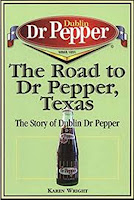The
Road to Dr Pepper, Texas: the Story of Dublin Dr Pepper, by Karen
Wright, was a book about the beverage, yes, but also about a small
town and a family. Early on all advertising was word of mouth.
Early on there was no caffeine in the ingredients. And, at one time,
it was used in the making of moonshine! In WWII one family member
was assigned to the medical corp because he had worked for a doctor
... and when he explained what Dr Pepper was (not who), he
was still assigned to the medical corp! When her father and husband
died, the daughter took over ... but since she had worked at every
job as she was growing up, she did a bang up job. When all other soft
drinks (including other Dr Pepper facilities) changed to high
fructose corn syrup (it's cheaper) this little plant did not ... nor
did it update the equipment ... instead, they used this as their
selling point and offered tours ... it was a huge success. The
formula is kept in vaults in two separate banks, and has never, ever
included prune juice. ;-)
Here's
something that would be a good read with the above book: Fizz: How
Soda Shook Up the World, by Tristan Donovan. For me the first
chapter was a bit dry, it's all about the chemical make up of fizzy
water! After that though, it was a good read. At first medicinal,
flavors were added to make it taste better (lots of them)! Soda
fountains took over during Prohibition and soon became a local
gathering place. Pepsi was the first to make short, 30 second
commercials (radio), Coke managed to bypass the sugar shortage in
WWII by convincing the government their product was necessary for
morale. Soon there were many variations, including those with as
much sugar and caffeine as allowed, to diet versions, to sports
drinks, power drinks and so on. Not a bad history!
Then,
move on to Sundae Best: a History of Soda Fountains, by
Anne Cooper Funderberg. Fizzy water was 'natural' at first, but soon
chemists figured out how to make their own ... then the problem
became containers. Ones that wouldn't leak or break under pressure.
As we learned in Fizz, a drink that was once a medicine became
a treat and things just sort of took off from there. Early on the
customer could pick a flavor, mix several, or ask for a 'don't care'
... that is, a drink that used up the last bits of whatever flavors
were just about gone. Presentation (and delivery) became popular and
the faucets got bigger, flashier, and more ornate (don't miss the
pictures in the back of the book). Soda fountains then embraced that
new fangled contraption known as the bicycle. Some even installed
bike racks and sold repair kits. After the war egg drinks were
popular. These required a certain 'choreography' to make properly
and provided entertainment to the customers. At some point someone
added ice cream. Soda fountains were a family friendly and
respectable place to gather. Once just a counter, they expanded to
include tables and then offer hamburgers, etc. Popularity dwindled
as fast food chains with pick up windows took over. Too bad! There's
a glossary of "hash house Greek" (the slang used for
orders) and a list of the movies including soda fountains. Nicely
done.
Reading
Hermit With Dog

No comments:
Post a Comment